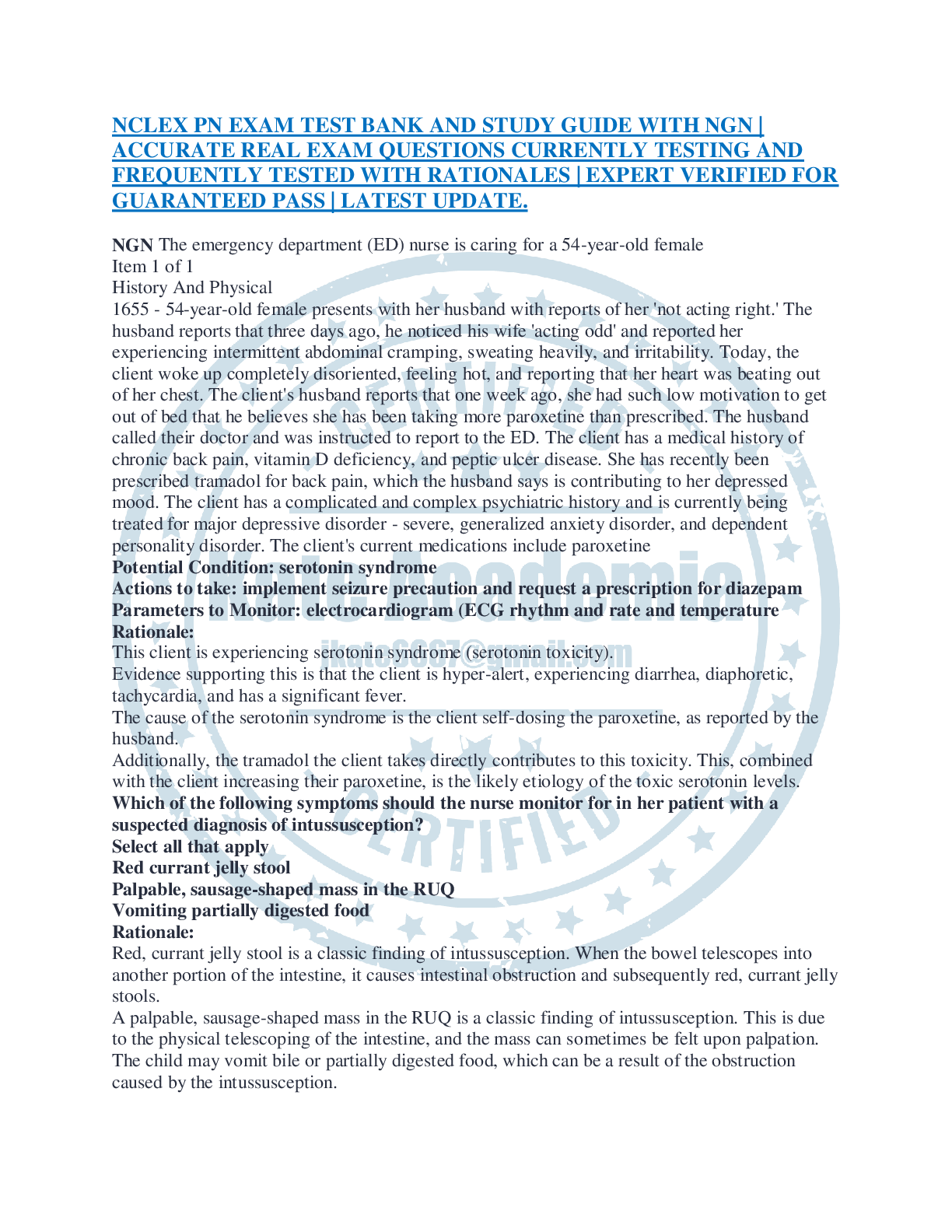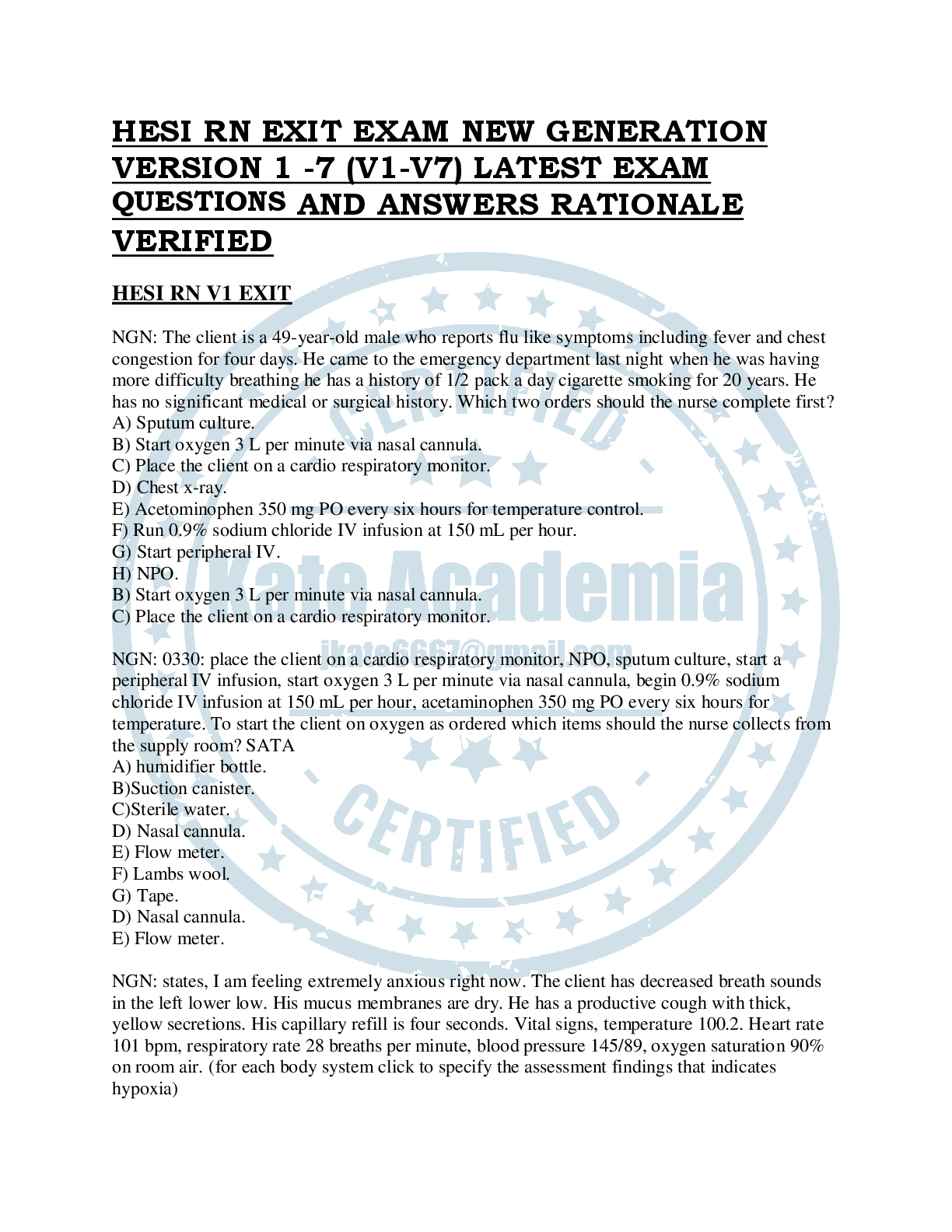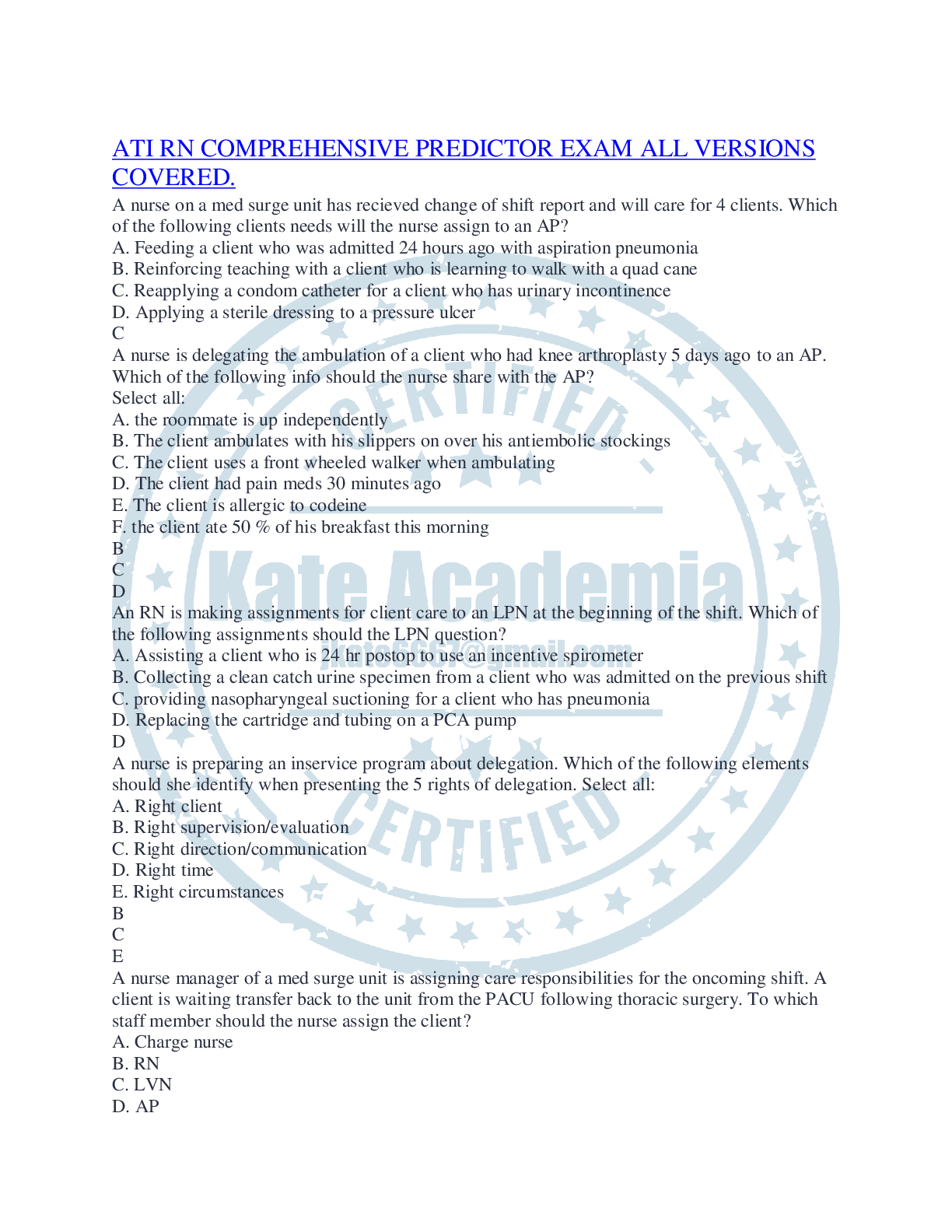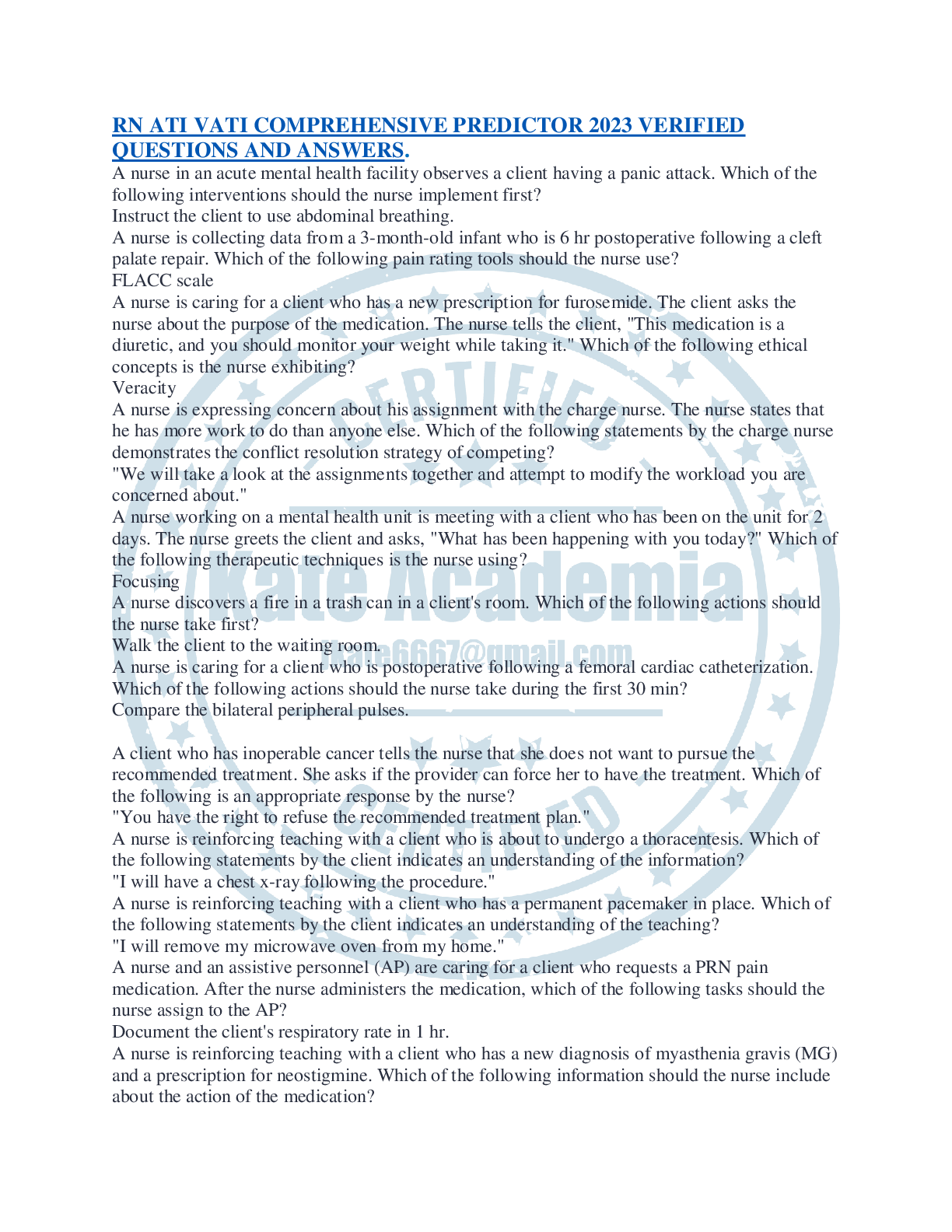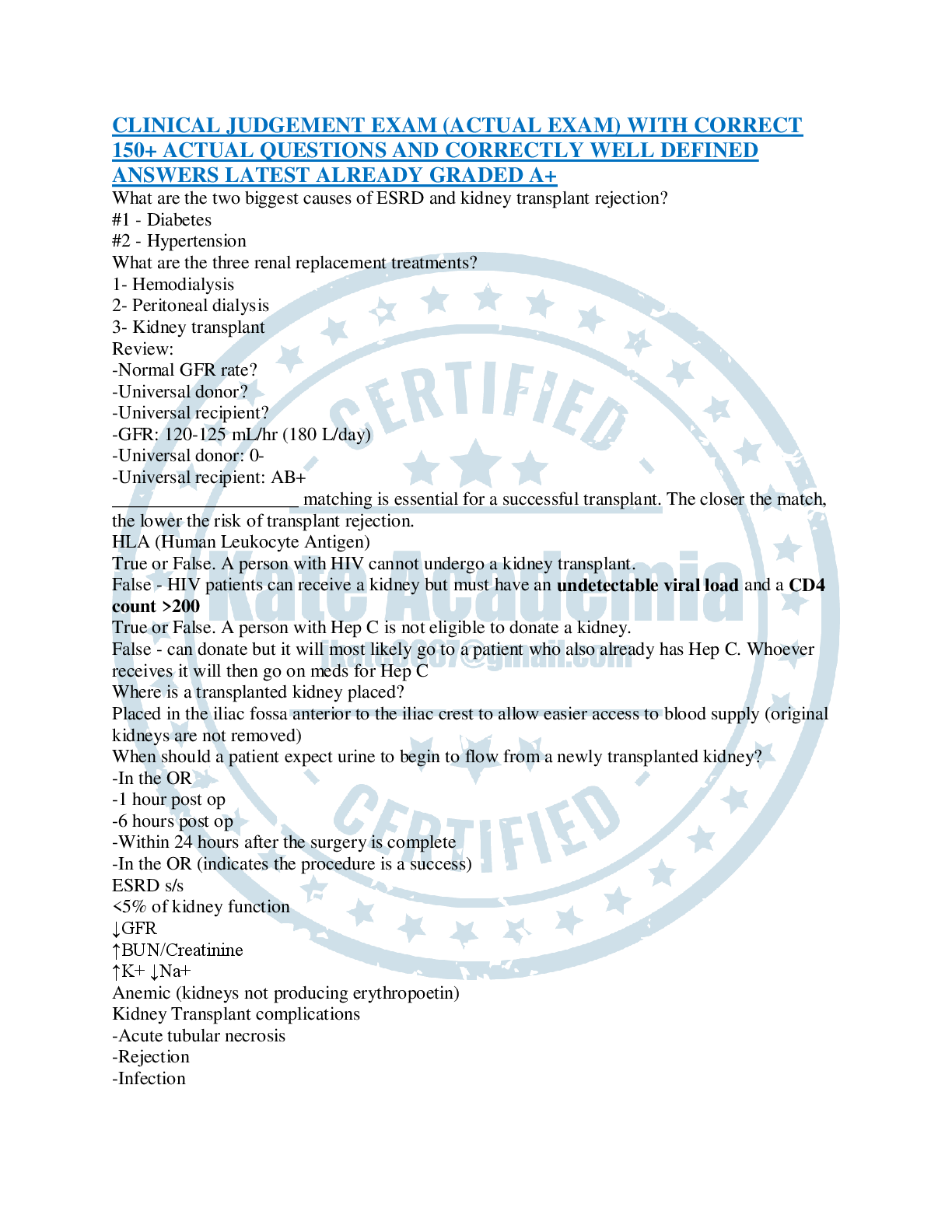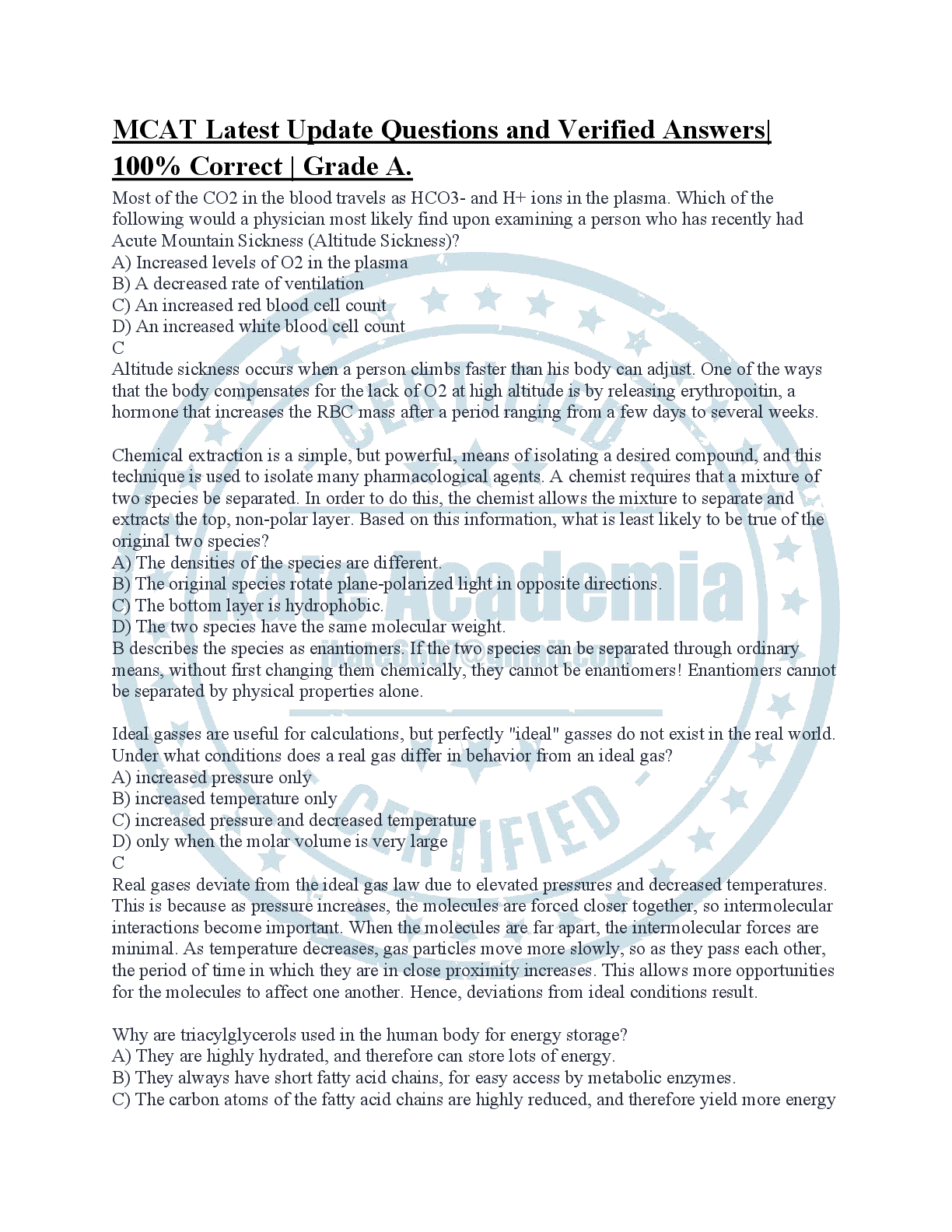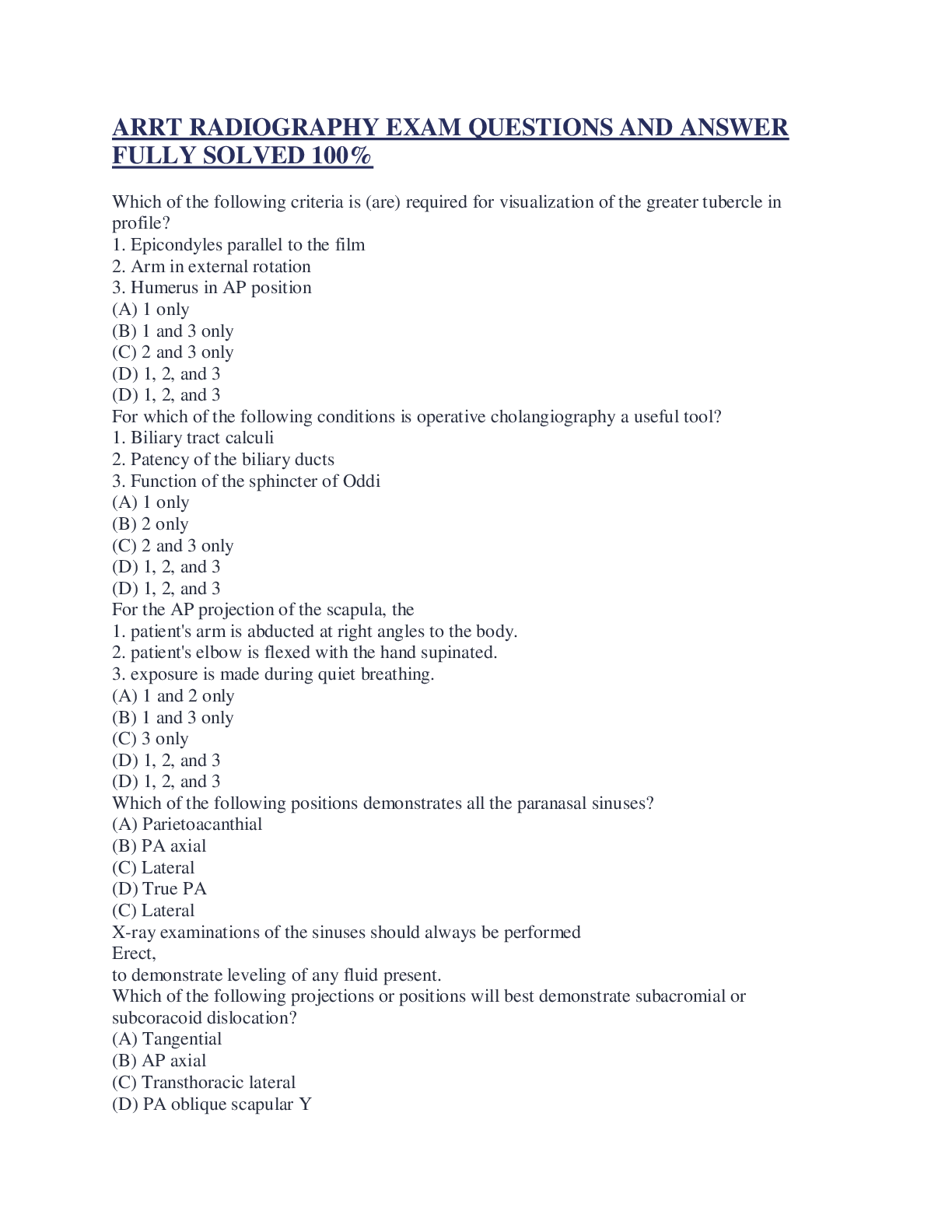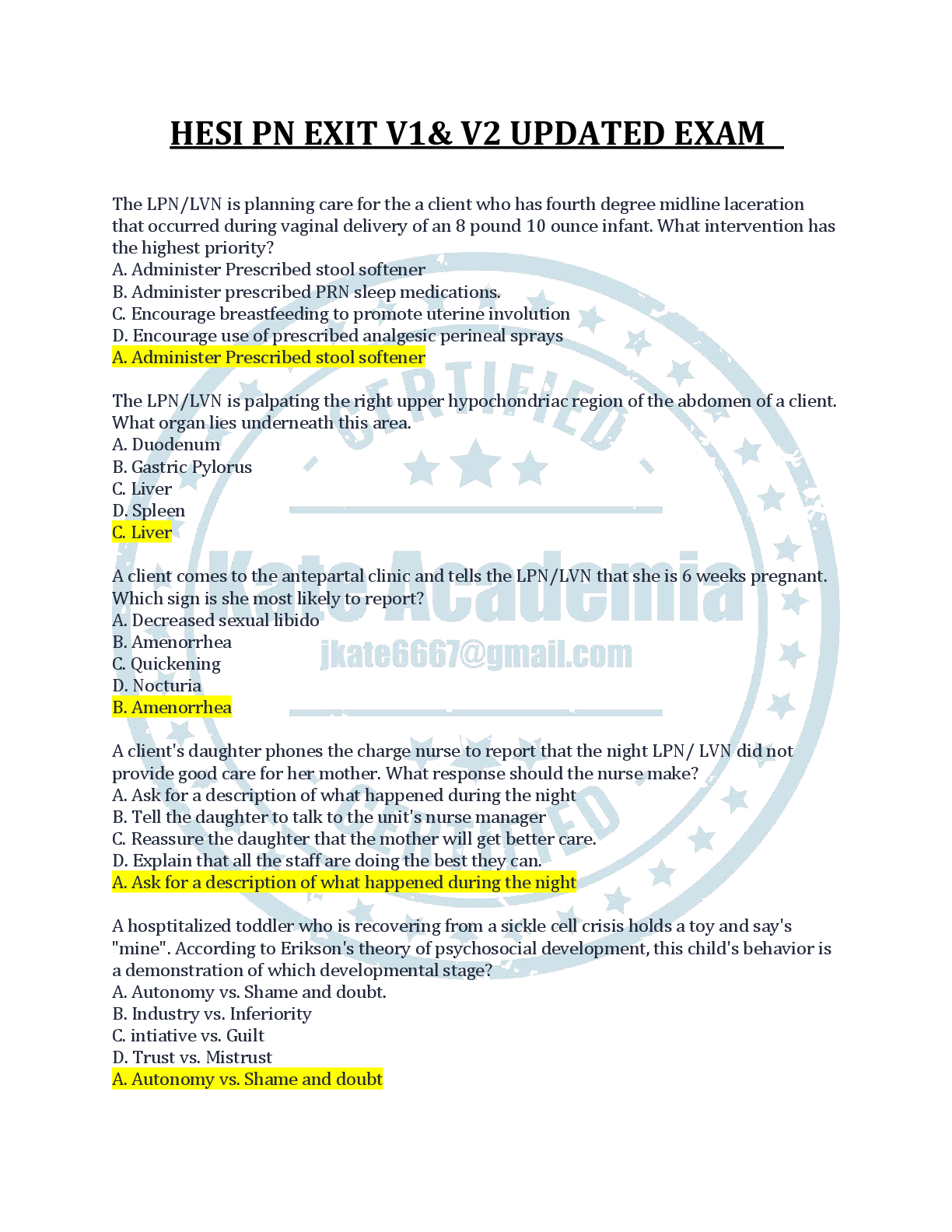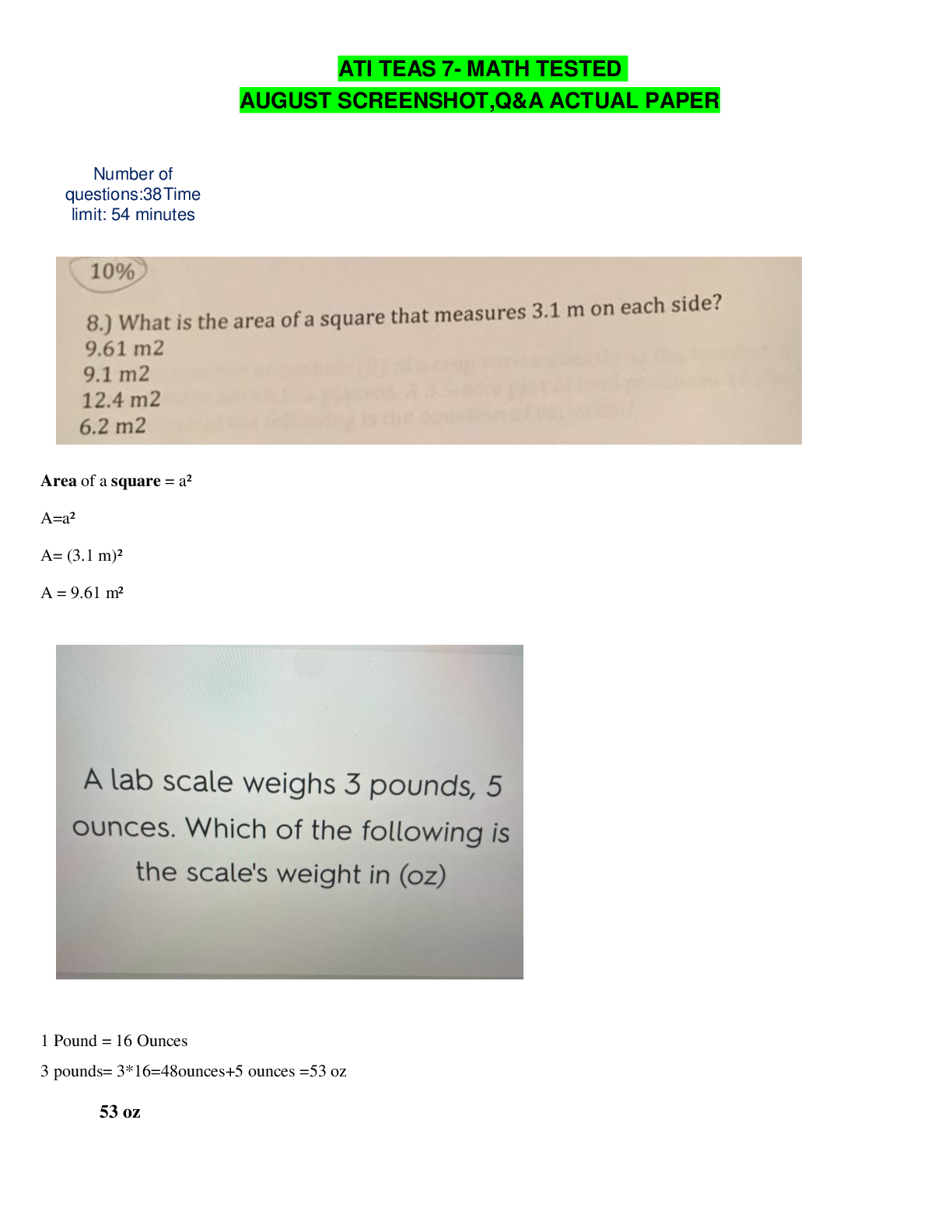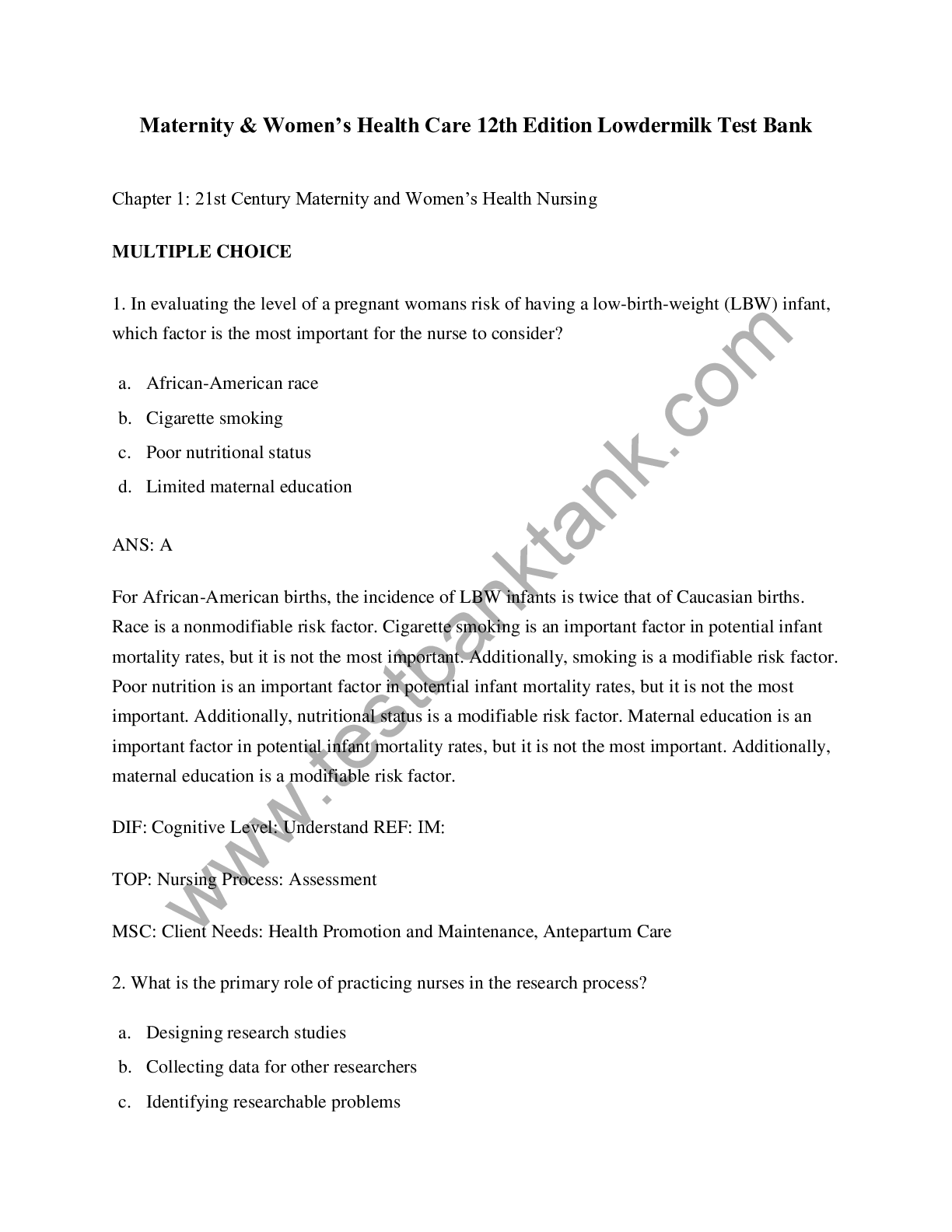*NURSING > EXAM > Porth’s Essentials Of Pathophysiology 5th Edition Test Bank | with Rationales (All)
Porth’s Essentials Of Pathophysiology 5th Edition Test Bank | with Rationales
Document Content and Description Below
Porth’s Essentials Of Pathophysiology 5th Edition Test Bank 1. Chapter 1 Although the basic structure of the cell plasma membrane is formed by a lipid bilayer, most of the specific membrane function... s are carried out by: A) Bound and transmembrane proteins B) Complex, long carbohydrate chains C) Surface antigens and hormone receptors D) A gating system of selective ion channels Ans: A Feedback: The functions of plasma membrane depend on the presence of proteins that are bound in the lipid bilayer and some that have the ability to pass freely into and out of the cell. Carbohydrate chains form a cell coat that surrounds the membrane and that contain surface antigens and surface hormone receptors. Some ion channels are gated and open only when the membrane potential changes significantly. 2. Which describes the function of the nucleus? A) It is basically the site of protein synthesis in the body. B) It contains the genetic code for the individual. C) It is the transformer of cellular energy. D) It initiates the process of aerobic metabolism. Ans: B Feedback: The nucleus contains DNA, which contains the genetic code that contains the information that controls cells. Ribosomes synthesize protein. Mitochondria transform organic compounds into cellular energy. Mitochondria require oxygen for aerobic metabolism, using hydrogen and carbon combined with oxygen molecules to form carbon dioxide and water as energy is released. 3. Which of the following aspects of the function of the nucleus is performed by ribosomal RNA (rRNA)? A) Copying and carrying DNA instructions for protein synthesis B) Carrying amino acids to the site of protein synthesis C) Providing the site where protein synthesis occurs D) Regulating and controlling protein synthesis Ans: C Feedback: There are three types of ribonucleic acid (messenger RNA, ribosomal RNA, and transfer RNA) that move to the cytoplasm and carry out the actual synthesis of proteins. Page 2 Messenger RNA (mRNA) copies and carries the DNA instructions for protein synthesis to the cytoplasm; ribosomal RNA (rRNA) is the site of protein synthesis; and transfer RNA (tRNA) transports amino acids to the site of protein synthesis for incorporation into the protein being synthesized. 4. Which accurately explains the functions of the organelles lysosomes? They: A) Are sacs filled with enzymes that breakdown and remove foreign substances and worn-out cell parts B) Function in association with the endoplasmic reticulum to modify protein end products and package them into secretory granules or vesicles C) Are small particles of nucleoproteins that are involved in the synthesis of proteins that remain in the cell as cytoplasmic structural or functional elements D) Are a dynamic system of interconnected membranous tubes that functions as a tubular communication system for transporting various substances from one part of the cell to another Ans: A Feedback: Lysosomes are sacs that are filled with hydrolytic enzymes that aid in the processing and removal of unwanted substances within the cytoplasm. The Golgi apparatus functions in association with the endoplasmic reticulum to modify and package substances in preparation for secretion, whereas ribosomes are small particles of nucleoproteins that are involved in the synthesis of proteins. The ER is a tubular communication system for transporting various substances from one part of the cell to another. 5. Impairment in the function of peroxisomes would result in: A) Inadequate sites for protein synthesis B) An inability to transport cellular products across the cell membrane C) Insufficient energy production within a cell D) Accumulation of free radicals in the cytoplasm Ans: D Feedback: Peroxisomes function in the control of free radicals; unless degraded, these highly unstable chemical compounds damage other cytoplasmic molecules. Peroxisomes do not directly contribute to energy production, protein synthesis, or transport of cellular secretions. Page 3 6. Although energy is not made in mitochondria, they are known as the “power plants” of the cell because they: A) Contain RNA for protein synthesis B) Utilize glycolysis for oxidative energy C) Extract energy from organic compounds D) Store calcium bonds for muscle contractions Ans: C Feedback: Mitochondria contain the enzymes needed for transforming organic compounds into energy that is easily accessible to the cell. Mitochondria contain their own DNA. Glycolysis is anaerobic metabolism and unrelated to oxidative energy. Mitochondria store phosphate bonds (such as in ATP) to power cellular functions. 7. Semen analysis indicates that the client's sperm have decreased motility. Which of the following cellular components may be defective within the client's sperm? A) Ribosomes B) Microtubules C) Mitochondria D) Microfilamen ts Ans: B Feedback: Abnormalities in the structure and function of microtubules and consequent dysfunction of the flagella may contribute to impaired sperm motility. Ribosomes, microfilaments, and mitochondria do not directly contribute to movement in cells such as cilia and flagella. 8. When explaining the function of glycolysis as it relates to anaerobic metabolism, the faculty will mention which of the following key points? Select all that apply. A) Glycolysis requires the use of oxygen to begin the process. B) Glycolysis occurs in mitochondrion-lacking cells. C) Glycolysis provides the majority of the body's energy needs. D) Pyruvic acid is an end result from a series of reactions that converts glucose. Ans: B, D Feedback: Glycolysis is the anaerobic process by which energy is liberated from glucose, and it is an important source of energy for cells that lack mitochondria. The process also provides a temporary source of energy for cells that are deprived of an adequate supply of oxygen. Glycolysis involves a sequence of reactions that converts glucose to pyruvic acid, with the concomitant production of ATP from ADP. It accounts for a small minority of the body's energy needs and Page 4 results. [Show More]
Last updated: 2 years ago
Preview 1 out of 536 pages
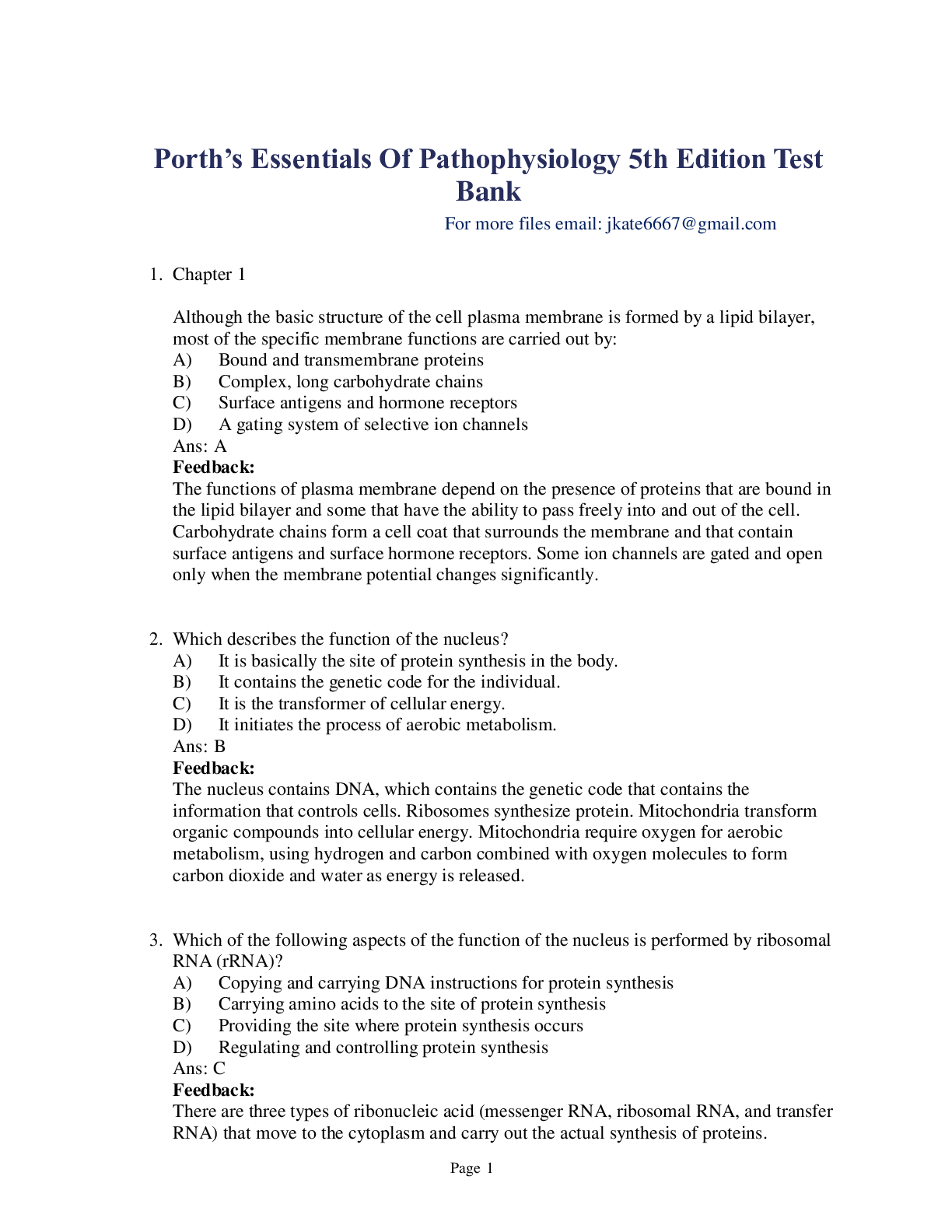
Buy this document to get the full access instantly
Instant Download Access after purchase
Buy NowInstant download
We Accept:

Reviews( 0 )
$16.50
Can't find what you want? Try our AI powered Search
Document information
Connected school, study & course
About the document
Uploaded On
Oct 17, 2022
Number of pages
536
Written in
Additional information
This document has been written for:
Uploaded
Oct 17, 2022
Downloads
0
Views
83



